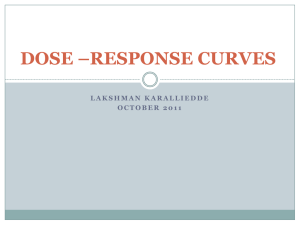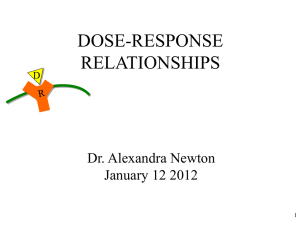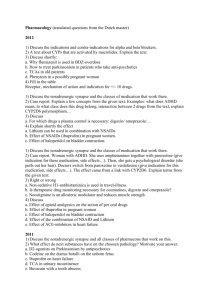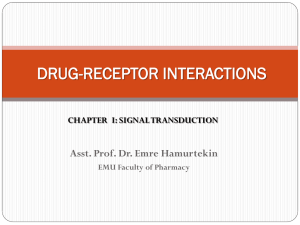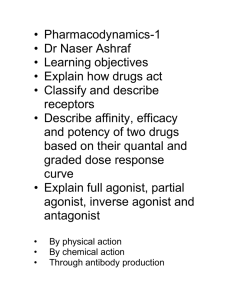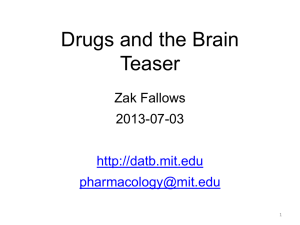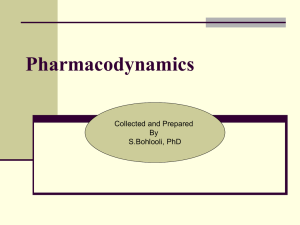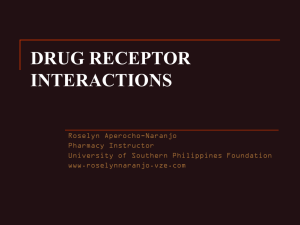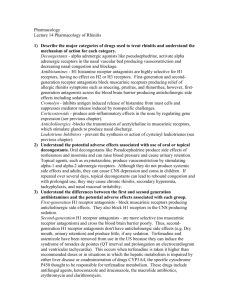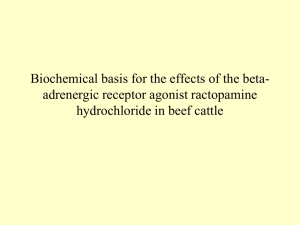Session 14 Pharmacodynamics
advertisement
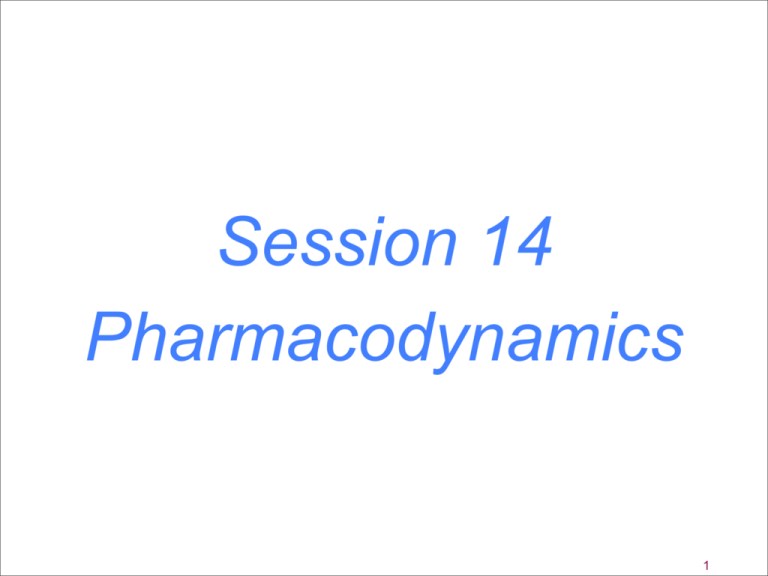
Session 14 Pharmacodynamics 1 Objectives • Receptor theory • Relation between Drug concentration and response • Drug potency & efficacy • Antagonists – competitive and unsurmountable • Partial and full agonists • Spare Receptors • Receptor-mediated signaling systems • Receptor-desensitization • Quantal dose-effect curves • Therapeutic index 2 Receptor Theory The existence of receptors was first inferred from observations of the chemical and physiological specificity of drug effects. Now receptors have been isolated biochemically and genes encoding receptor proteins have been cloned and sequenced. Receptors determine the quantitative relationship between drug dose and pharmacologic effect Receptors are responsible for the selectivity of drug action Receptors mediate the actions of pharmacologic agonists and antagonists 3 What are Drug Receptors? Cell surface or intracellular regulatory proteins – mediate the effects of endogenous chemical signals such as neurotransmitters and hormones. e.g. adrenoreceptors, steroid receptors, acetylcholine receptors. Enzymes – cell surface, membrane-spanning or intracellular proteins inhibited (or less commonly activated) by the binding of a drug. e.g. Na+K +ATPase is the cell surface receptor for cardiac glycosides such as digitalis Structural proteins – extra- or intracellular proteins inhibited (or less commonly activated) by the binding of a drug. e.g.tubulin is the receptor for colchicine - an anti-inflammatory agent 4 Exam-type question One of the following is incorrect. Drug receptors: a. Are found only at the surface of cells b. Are responsible for the selectivity of drug action c. Mediate the actions of pharmacologic agonists and antagonists d. Determine the quantitative relationship between drug dose and pharmacologic effect e. May be structural proteins 5 Relation between Drug concentration and response The relation between drug dose and the clinically observed response may be quite complex. However, in carefully controlled in vitro systems, the relationship between drug concentration and its effect is often simple and may be described with mathematical precision. 100 Effectmax 90 90 80 80 % of maximal effect % of maximal effect 100 70 60 50 0.5 Effectmax 40 30 20 Effectmax 70 60 0.5 Effectmax 50 40 30 20 10 EC50 EC50 10 0 0 0 10 20 30 [Drug] 40 50 60 0.01 0.1 1 10 100 1000 10000 [Drug] (log scale) 6 Relation between Drug concentration and response This relationship should be familiar to you. These curves are MichaelisMenten curves or rectangular hyperbolae (Biochemistry - Enzyme kinetics) Effect max [Drug] Effect = EC50 +[Drug] 100 EC50 is that concentration of drug that produces a response one-half of the maximum response 90 80 % of maximal effect €the maximum response Effectmax is of the system to the drug Effectmax 70 60 0.5 Effectmax 50 40 30 20 EC50 10 0 0 10 20 30 40 50 60 [Drug] 7 Relation between Drug concentration and response Why is this observed? Because drug binding to its “receptor” is characterized by saturation kinetics. Consider the ligand L and its cognate receptor R. The Law of Mass Action tells us that the equilibrium constant for R.L formation is given by: [ R.L ] = kon = K eq [ R][ L ] koff The fraction of total receptor that exists as R.L is: € f R.L R.L L = = [R] + [R.L] koff + L k on 8 Plotting fR.L versus [L] shows that: 1 [R.L] = [Rtotal] 0.9 [R.L]/([R]+[R.L]) 0.8 0.7 0.6 0.5 [R.L] = 0.5 [Rtotal] 0.4 0.3 0.2 koff/kon = KD 0.1 0 0 10 20 30 40 50 60 [L] Thus available receptors are 50% occupied by drug when [drug] = koff/kon Note kon is a second order rate constant - units are per M per sec koff is a first order rate constant - units are per sec koff/kon is the dissociation constant KD of the R.L complex and has units of M 9 Relation between Drug concentration and response Since the magnitude of the response of a “receptor” to a drug must be proportional to the concentration of bound drug, it makes sense that: 1) Response and drug binding curves are similar, and 2) EC50 is related to KD. 10 Exam-type question For an isolated, simple receptor (R) system of the type R+ L ↔ R⋅ L KD for ligand (L) binding: a. Is that [ligand] at which maximum binding is € observed b. Is the equilibrium constant for R.L formation c. Has units of per M d. Is a second order rate-constant e. Is that [Ligand] at which one-half of the receptor exists as R.L. 11 DRUG Potency & Efficacy Efficacy is the maximum effect (Effectmax) of a drug. Potency, a comparative measure, refers to the different doses of two drugs needed to produce the same effect. In this figure, Drugs A & B have the same efficacy. 120 % of maximal effect 100 Drug A has greater potency than B or C because the dose of B or C must be larger to produce the same effect as A. Drug A 80 Drug B 60 0.5 Effectmax 40 20 Drug C 0.5 Effectmax 0 -12 Normally we plot data as effect versus log[Drug]. This makes it easier to determine EC50s and to compare drug efficacy & potency. -10 -8 log[Agonist] -6 -4 Although Drug C has lower efficacy than B, it is more potent than B at lower drug concentrations 12 Exam-type question Drug A has an EC50 of 10 nM and a maximum effect of 95%. Drug B has an EC50 of 75 nM and a maximum effect of 100%. Drug C has an EC50 of 190 nM and a maximum effect of 34%. Which of the following is correct? a. Drug B is the most potent drug. b. Drug A has the highest efficacy. c. Drug C has the lowest efficacy but highest potency. d. Drug A is the most potent drug. e. Drug B shows the lowest potency. 13 General Classes of Antagonists Chemical Antagonists One drug may antagonize the action of a second by binding to and inactivating the second drug. e.g. protamine (a positively charged protein at physiologic pH) binds (sequesters) heparin (a negatively charged anticoagulant) making it unavailable for interactions with proteins involved in the formation of blood clots. Physiological Antagonists Physicians often prescribe drugs that take advantage of physiologic antagonism between endogenous regulatory pathways. Thus the catabolic actions of glucocorticoids lead to increased blood sugar - an effect opposed by insulin. While glucocorticoids and insulin act on quite different pathways, insulin is sometimes administered to oppose the hyperglycemic action of glucocorticoid hormone - whether resulting from increased endogenous synthesis (e.g. a tumor of the adrenal cortex) or as a result of glucocorticoid therapy. Pharmacological Antagonists Drugs that bind to receptors but do not act like agonists and, therefore, do not alter receptor function. These antagonists may block the ability of agonists to bind to the receptor by competing for the same receptor site or may bind to another site on the receptor that blocks the action of the agonist. In both cases, the biological actions of the agonist are prevented. 14 Competitive and Irreversible Antagonists Receptor antagonists bind to the receptor but do not activate it. In general the effects of these antagonists result from preventing agonists from binding to and activating receptors. Antagonists may be competitive (reversibly displaced by agonists) or noncompetitive (not reversibly displaced by agonists). Competitive (surmountable or reversible) Antagonists A competitive antagonist,C, competes with the agonists A for binding to the receptor, R. KD for C binding = K C = kCoff kCon KD for A binding = K A = k Aoff k Aon You know € from the Law of Mass Action that increasing [C] € will shift the equilibrium to the left reducing the amount of productive (effective) receptor.agonist complex. Increasing [A] will shift the equilibrium to the right reducing the amount of unproductive receptor.antagonist complex. 15 How do we measure KC if it does not directly produce an effect? We measure KC by analyzing its capacity to compete with and thus reduce the effect of an agonist. Agonist A plus increasing concentrations of competitive antagonist C 120 Dose Ratio The ratio: % of maximal effect 100 agonist concentration (dose) required to produce a given response (effect) in the presence of an antagonist 80 60 agonist concentration (dose) required to produce the same response (effect) in the absence of antagonist 0.5 Effectmax 40 20 0 -11 -10 -9 -8 -7 -6 -5 -4 log[Agonist] 16 Dose Ratio In the presence of antagonist, C: In the absence of antagonist, C: € Effect max [A1 ] Effect1 = [C] EC50 (1+ ) +[A1 ] KC Effect max [A2 ] Effect2 = EC50 +[A2 ] Since Effect1 = Effect2, it can be shown that the Dose Ratio: € [C] EC50 (1+ ) [A1 ] [C] [C] KC Dose ratio = = = (1+ )∴ Dose ratio −1 = [A2 ] EC50 KC KC 17 Schild Plot for Competitive Antagonist Thus: log(Dose Ratio -1) = log ([C]/KC) log(Dose Ratio -1) = log[C] + log(1/KC) y = x + intercept When y = 0, this means that x+intercept = 0. Thus log([C]/KC) = 0, hence [C]/KC =1. Therefore the x-intercept (y = 0) =log KC log (Dose ratio -1) 1.5 1 y=x+7 0.5 0 -8.5 -0.5 -1 -8 -7.5 -7 -6.5 -6 Log KC -5.5 -5 The Schild plot is useful in the development of improved antagonists log[C] -1.5 18 Implications for the clinician 1) The extent of inhibition depends on the antagonist’s concentration. Thus the extent and duration of an antagonists action depends upon its concentration in the plasma which in turn is influenced by the rate of its metabolic clearance or excretion. Different patients receiving a fixed dose of propranolol (a competitive ß-adrenoreceptor antagonist) exhibit wide range of [propranolol]plasma owing to differences in drug clearance. Thus the effect of this competitive antagonist of norepinephrine may vary widely in patients and the dose must be adjusted accordingly. 2) The extent of inhibition depends upon the concentration of the competing Agonist e.g. when propranolol is administered in sufficient doses to to block the effects of basal levels of the neurotransmitter norepinephrine, resting heart rate is decreased. However, elevated norepinephrine levels resulting from exercise, postural changes or emotional stress may suffice to overcome competitive antagonism by propranolol and increase heart rate. Thus the prescriber must always consider possible changes in endogenous [agonist] that might influence the therapeutic response. 19 NonCompetitive (Unsurmountable) antagonists Some receptor antagonists bind to the receptor at sites unrelated to the agonist binding site. Binding of this antagonist is not reversible or surmountable by increasing [agonist]. Other antagonists may form covalent bonds with the receptor at the agonist binding site and, therefore, form an irreversible complex with the receptor. The number of remaining unoccupied receptors may be too low for even high concentrations of agonist to elicit a maximal response. Advantages of irreversible inhibitors Once the receptor is occupied by antagonist, the inhibitor need no longer be present in unbound form to inhibit the effects of an agonist. Thus the duration of action of such an inhibitor is relatively independent of its rate of elimination and more dependent on the rate of turnover of receptor molecules. 120 % of maximal effect 100 Competitive antagonist Control 80 60 0.5 Effectmax 40 20 Noncompetitive antagonist 0.5 Effectmax 0 -11 -10 -9 -8 -7 log[Agonist] -6 -5 -4 Disadvantages of irreversible inhibitors Phenoxybenzamine, an irreversible α– adrenoreceptor antagonist, is used to control hypertension caused by catecholamines released by tumors of the adrenal medulla (pheochromocytoma). Thus blockade can be maintained even during episodic bursts of catecholamine release. If overdose occurs, however, α–adrenoreceptor blockade cannot be overcome by agonist. The effects must be antagonized physiologically by using a pressor agent that does not act via α–adrenoreceptors (e.g. angiotensin II, vasopressin). 20 Exam-type question A simple, reversible competitive antagonist is expected to acutely: a. Reduce the efficacy of an agonist. b. Reduce the potency of an agonist. c. Reduce both the potency and efficacy of an agonist. d. Increase the potency of an agonist. e. Increase the efficacy of an agonist. 21 Exam-type question In the absence of a “spare receptor” effect, a simple, irreversible noncompetitive antagonist is expected to acutely: a. Reduce the efficacy of an agonist. b. Increase the EC50 of an agonist. c. Increase the EC50 and reduce the efficacy of an agonist. d. Reduce the EC50 of an agonist. e. Increase the efficacy of an agonist. 22 Partial and Full Agonists Agonists may differ in how tightly they bind to their receptors (potency) and in the effect they produce (efficacy). Some drugs may bind very tightly (are highly potent) but produce only a modest effect (low efficacy). Low efficacy drugs are termed “partial agonists” while the structurally related drugs which produce a full effect are called “full agonists”. 120 Partial Agonist C Full Agonist B Full Agonist A % of maximal effect 100 80 60 40 20 0 -3 -2 -1 0 1 2 3 4 log[Drug] 23 How can an agonist be “partial”? The molecular basis of partial agonism is unknown. At least 2 theories have been proposed: 1) The partial agonist may fit the receptor binding site well but is less able to promote the receptor conformational change leading to transduction. 2) The receptor may isomerize between 2 states – A (active) and I (inactive). If the A form has high affinity for the agonist (L), the equilibrium will be shifted in favor of AL and full activation might be achieved. If I and A forms of the receptor share similar affinities for L, both AL and IL will be formed but only AL will produce an effect and the agonists will appear partial. I.L (inactive) L+I A+L A.L (active) 24 Weak partial agonists are also competitive antagonists! 120 120 Partial Agonist B 100 % of maximal binding Full Agonist A Drugs A & B have equal affinities for the receptor but B is a partial agonist 80 60 40 20 0 -11 80 60 40 Here, [A] is fixed and [B] is varied. As [B] increases, it displaces A and occupies all receptors. Partial Agonist B Full Agonist A 20 -9 -7 0 -5 -12 log[Drug] -10 -8 -6 -4 log[Drug B] 100 80 % of maximal effect % of maximal effect 100 [A] = 0.26 µM [B] is varied Again, [A] is fixed and [B] is varied. The responses elicited by A and B are shown and the sum of their responses is also shown. Because the response to B is less than that to A, saturating B reduces the overall response of the system [A] = 0.26 µM [B] is varied 60 Partial Agonist B 40 Full Agonist A Total response 20 0 -12 -10 -8 -6 -4 log[Drug] 25 Exam-type question Partial agonists can serve as competitive antagonists because: a. b. c. d. e. Their effects on receptors are additive. They displace endogenous agonists from receptor binding sites. They mimic the actions of agonists. They show greater efficacy than endogenous agonists. They physically chelate endogenous agonists. 26 Receptor-Effector Coupling and Spare Receptors Agonist binding to a receptor and its binding-induced receptor conformational change are normally only the first of many steps required to produce a pharmacological effect. e.g. contrast the actions of the nicotinic receptor agonist acetylcholine with that of beta adrenergic receptor agonist epinephrine. Ach binding to the AChR results in an instantaneous opening of the channel pathway and cation flow through the pore. 27 28 The transduction process between receptor occupancy and drug response is termed coupling. The efficiency of coupling is partly determined by the initial conformational change in the receptor. Thus the effects of full agonists may be more efficiently coupled to receptor occupancy than those of partial agonists. However, coupling efficiency is also determined by the biochemical events that transduce receptor occupancy into cellular response. High efficiency coupling may also result from spare receptors. Receptors may be considered spare when the maximal response is elicited by an agonist at a concentration that does not produce full occupancy of the available receptors. Spare receptors are not different from “nonspare” receptors. They are not hidden. When they are occupied they can be coupled to response. Spare receptors may be demonstrated by using irreversible antagonists to inhibit binding of agonists to a portion of the receptor pool then demonstrating that a high concentration of agonist may still produce an undiminished maximal response. e.g. A maximal inotropic response of heart muscle to catecholamines can be elicited when 90% of the ß-adrenoreceptors are occupied by a quasi-irreversible antagonist. Thus myocardium is said to contain a large proportion of spare ßadrenoreceptors. 29 120 100 % of maximal effect A 80 B C 60 Increasing concentration of irreversible inhibitor D 0.5 Effectmax 40 E 20 0 -11 -10 EC50 (A) -9 -8 -7 -6 EC50 (B) EC50 (C) -5 -4 EC50 (D,E) =KD Log [Agonist] M 30 How do we account for Spare Receptors? In some instances, the mechanism is understood. For example, the binding of GTP by an intermediate may greatly outlast agonist-receptor interaction. In this case the “spareness” of receptors is temporal. In other cases where the mechanisms are not understood, we imagine the receptors are spare in number. 31 1000 receptors 10 enzymes KD = 0.5 µM At 2.5 nM ligand, saturation = 2.5 ×10 −9 = 0.005 −7 −9 5 ×10 + 2.5 ×10 receptors activated = 0.005 ∗ 1000 = 5 25 receptors €ligand, At 125 nM saturation = 10 enzymes KD = 0.5 µM 125 ×10 −9 = 0.2 −7 −9 5 ×10 +125 ×10 receptors activated = 0.2 ∗ 25 = 5 32 Exam-type question Spare receptors are evidenced by : a. The use of competitive antagonists. b. The inability of agonists to fully activate the receptor. c. Full activation of the response at [agonist] where receptor occupancy is sub-maximal. d. Complete suppression of the response by irreversible antagonists. e. Reduced efficacy at high [antagonist]. 33 Exam-type questions percent of maximum 120 100 80 c 60 a 40 20 0 -10 e d b -8 -6 -4 -2 0 log dose Which curve best describes percentage binding of a full agonist to its receptor as the concentration of partial agonist is increased from low to very high levels? Which curve best describes the percentage effect when a full agonist is present throughout the experiment and the concentration of partial agonist is increased from low to very high levels? Which curve best describes percentage binding of the partial agonist whose effect is shown by curve b if the system has many spare receptors? 34 Quantal Dose-Effect Curves It is not always possible to construct graded dose-response curves if the pharmacological response is an either-or (quantal) event such as: prevention of convulsions, arrhythmia or death. The clinical relevance of a quantitative DR relationship in a single patient may be limited in application to other patients owing to the great potential variability among patients in severity of disease and responsiveness to drugs. One solution is to determine the quantity of drug required to produce a specific magnitude of effect in a large number of patients (or animals). The cumulative frequency distribution of response is then plotted versus log dose. The quantal effect may be chosen on the basis of clinical relevance (e.g. relief of headache), preservation of safety of subjects (low dose of cardiac stimulant producing an increase in heart rate of 20 beats/min) or it may be an inherently quantal event (death). 35 For most drugs, the dose required for quantal effects are log-normally distributed and when the responses are summated, the cumulative frequency distribution constitutes a quantal dose-effect curve (or dose-percent curve) of the proportion or percentage of individuals whose exhibit the effect as a function of log dose. The quantal dose effect curve is characterized by the median effective dose (ED50) - the dose at which 50% of individuals show the specified quantal effect The dose required to produce a particular toxic effect in 50% of animals is called the median toxic dose (TD50). If the toxic effect is death of the animal, a median lethal dose (LD50) may be defined. 36 Therapeutic Index Quantal dose effect curves permit an analysis of the margin of safety (or selectivity in response) for a specific drug. In animal studies, the therapeutic index is defined as the ratio of the TD50 to ED50. Thus if TD50 = 500 mg and ED50 = 5 mg, the drug is 100-fold more selective for the desired response and the therapeutic index is 100. The therapeutic index in humans is never known with great precision. Drug trials and accumulated clinical experience indicate a range of effective doses and a different (but sometimes overlapping) range of possibly toxic doses. Clinically acceptable risk depends on the severity of the disease being treated. e.g. dose range of a drug for relief from headache should be much lower than the dose range that produces toxicity even if only a small % of individuals show toxic effect. With a lethal disease such as Hodgkin's lymphoma, the acceptable difference between therapeutic and toxic doses may be smaller. 37 Exam-type question Which of the following provides information about the variation in sensitivity to a drug within a population studied? a. b. c. d. e. Potency. Maximal efficacy. Therapeutic index. Quantal dose-response curve. Graded dose-response curve. 38 Exam-type question A drug has an ED50 of 5 mg/kg adult body weight and a TD50 of 250 mg/kg body weight.The therapeutic index of the drug is: a. b. c. d. e. Indeterminate. 0.02 50 Too low to make the drug useful. Too high to make the drug safe. 39 Summary • Receptor theory receptors mediate drug actions • Relation between Drug concentration and response Michaelis-Menten (saturation) curves • Drug potency & efficacy EC50 vs Maximum response • Antagonists – competitive and unsurmountable reversible binding to agonist site and irreversible/ reversible binding to non-agonist sites incomplete and complete mimics of natural agonist • Partial and full agonists • Spare Receptors • of drug required for a specific Quantal dose-effect curves quantity magnitude of effect in a large population • Therapeutic index Full response at subsaturating [agonist] the ratio of the TD50 to ED50 40
